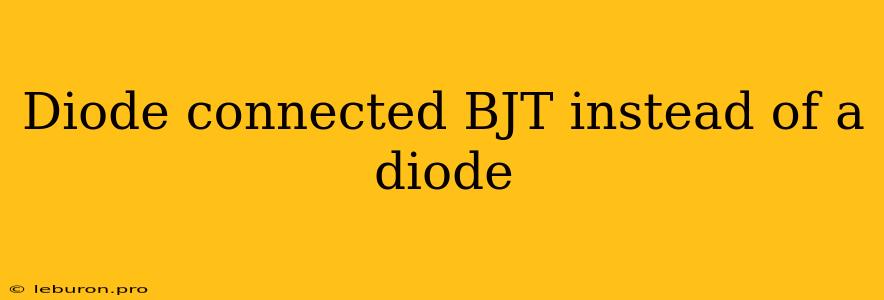The Clever Trick: Using a BJT as a Diode
In the world of electronics, diodes are ubiquitous components, known for their simple yet crucial role in rectifying AC signals, protecting circuits from reverse voltage, and providing switching functionality. But what if you find yourself in a situation where a diode isn't readily available? Or perhaps you want to achieve a specific characteristic that a standard diode can't provide. Enter the diode-connected BJT, a clever and often overlooked technique that lets you repurpose a bipolar junction transistor (BJT) to emulate the behavior of a diode. This approach not only offers an alternative solution but can also unlock unique advantages in circuit design.
Understanding the Basics: Diodes and BJTs
Before delving into the intricacies of using a BJT as a diode, let's quickly recap the fundamental operation of these components.
Diodes: A diode is a two-terminal semiconductor device characterized by its unidirectional current flow. It allows current to flow easily in one direction (forward bias) and blocks it in the opposite direction (reverse bias). This property arises from the specific doping of the semiconductor materials within the diode.
BJTs: A BJT, on the other hand, is a three-terminal device with two PN junctions. These junctions, known as the emitter-base junction and the collector-base junction, control the flow of current between the emitter and collector. The key to understanding BJT operation lies in the concept of current amplification: a small base current can control a much larger collector current.
The Magic of Diode Connection: Repurposing a BJT
The core idea behind using a BJT as a diode lies in creating a specific configuration where the transistor essentially acts as a single PN junction, mirroring the behavior of a diode. This is achieved by connecting the collector and base terminals of the BJT together, effectively creating a single, common terminal. This connection is what gives the configuration its name: diode-connected BJT.
How it Works:
-
Forward Bias: When a positive voltage is applied to the emitter (the common terminal), the emitter-base junction becomes forward biased. This allows a small base current to flow, which in turn triggers a much larger collector current. Since the collector and base are connected, this current essentially flows out of the common terminal, mimicking the behavior of a forward-biased diode.
-
Reverse Bias: If a negative voltage is applied to the emitter, the emitter-base junction becomes reverse biased. This prevents any significant current flow, similar to a reverse-biased diode.
Advantages of Using a Diode-Connected BJT:
- Improved Performance: In some applications, a diode-connected BJT can offer superior performance compared to a standard diode. For instance, it can have lower forward voltage drop and faster switching speeds.
- Flexibility: The diode-connected configuration allows you to exploit the current amplification capability of the BJT, providing a flexible and controllable way to achieve diode-like behavior.
- Availability: In situations where a diode is unavailable, a BJT can serve as a readily available alternative, offering a practical workaround.
Applications of Diode-Connected BJTs:
- Voltage Clamping: Similar to how a regular diode can clamp a voltage to a specific level, a diode-connected BJT can be used in voltage clamping circuits, protecting sensitive components from overvoltages.
- Rectification: Although not as efficient as dedicated rectifier diodes, a diode-connected BJT can be employed for simple AC-to-DC rectification tasks.
- Active Load: In active load circuits, a diode-connected BJT can be used to create a load with a specific voltage drop, enhancing the performance of amplifiers and other circuits.
- Level Shifting: By introducing a voltage drop across the diode-connected BJT, you can shift the voltage level of a signal, which can be useful in signal processing and logic circuits.
Practical Considerations:
- Choosing the Right BJT: The performance of a diode-connected BJT is dependent on the characteristics of the specific transistor used. Factors like beta (current gain), saturation voltage, and switching speed should be considered when selecting a BJT for this application.
- Temperature Effects: The forward voltage drop of a diode-connected BJT can vary with temperature. This factor should be accounted for in circuits that are sensitive to temperature variations.
- Current Limiting: Since a diode-connected BJT can amplify current, it's important to ensure appropriate current limiting mechanisms are in place to prevent excessive current flow and potential damage to the transistor.
Conclusion:
The diode-connected BJT is a testament to the versatility and flexibility of semiconductor devices. By understanding the principles behind this configuration, you can unlock a powerful tool in your electronics design toolkit. While it might seem like a simple concept, the ability to repurpose a BJT as a diode opens up a world of possibilities, enabling you to achieve unique characteristics and enhance the performance of your circuits. So next time you're faced with a design challenge involving diodes, remember the diode-connected BJT - a clever trick that can often provide the solution you need.
